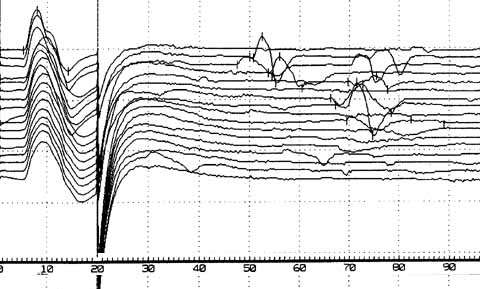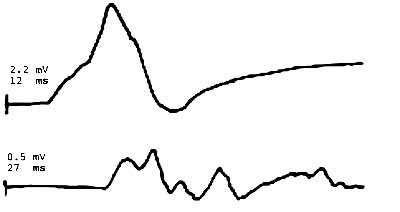- F-waves: General
- Late motor response: Occurs after CMAP
- Physiology
- Mechanism: Pure motor, single axon circuitry
- 1st phase: Antidromic impulse along motor axon
- 2nd phase: Depolarization of cell body
- 3rd phase
- Orthodromic impulse along motor axon
- Occurs after refractory period ends
- No synapses involved
- Stimulus needed: Maximal
- Latencies: Distal stimulation
- Arms: 25 to 32 ms
- Legs: 45 to 56 ms
- Varied from stimulus to stimulus
- Chronodispersion: Arms 4 ms; Legs 6 ms
- Longer: Increased patient height
- Pre-term Infants
1
- Increasing gestational age: Shorter latency
- Amplitude: 1% to 5% of CMAP
- F-wave persistence
- Definition: # F-waves/# Stimulations
- Normal: Usual 80% to 100%; Always > 40%
- Lowest in: Peroneal nerve (40%)
- Other features
- May be difficult to elicit in some normals
- Reduced or absent with
- Sleep or sedation
- Reduced CMAP amplitude
- Increased with Jendrassik maneuver (Reinforcement)
- Utility
- Most useful: Nerves to distal extremities
- Useful for: Conduction in proximal areas of axons
- F-waves: Disorders
- Demyelinating neuropathy
- Number: Reduced
- Impersistence
- Latencies: Prolonged & Variable
- Demyelinating GBS
- Loss may be earliest, or only, sign of demyelination
- SBMA: Giant F-waves
- Also see: H-reflex
|

